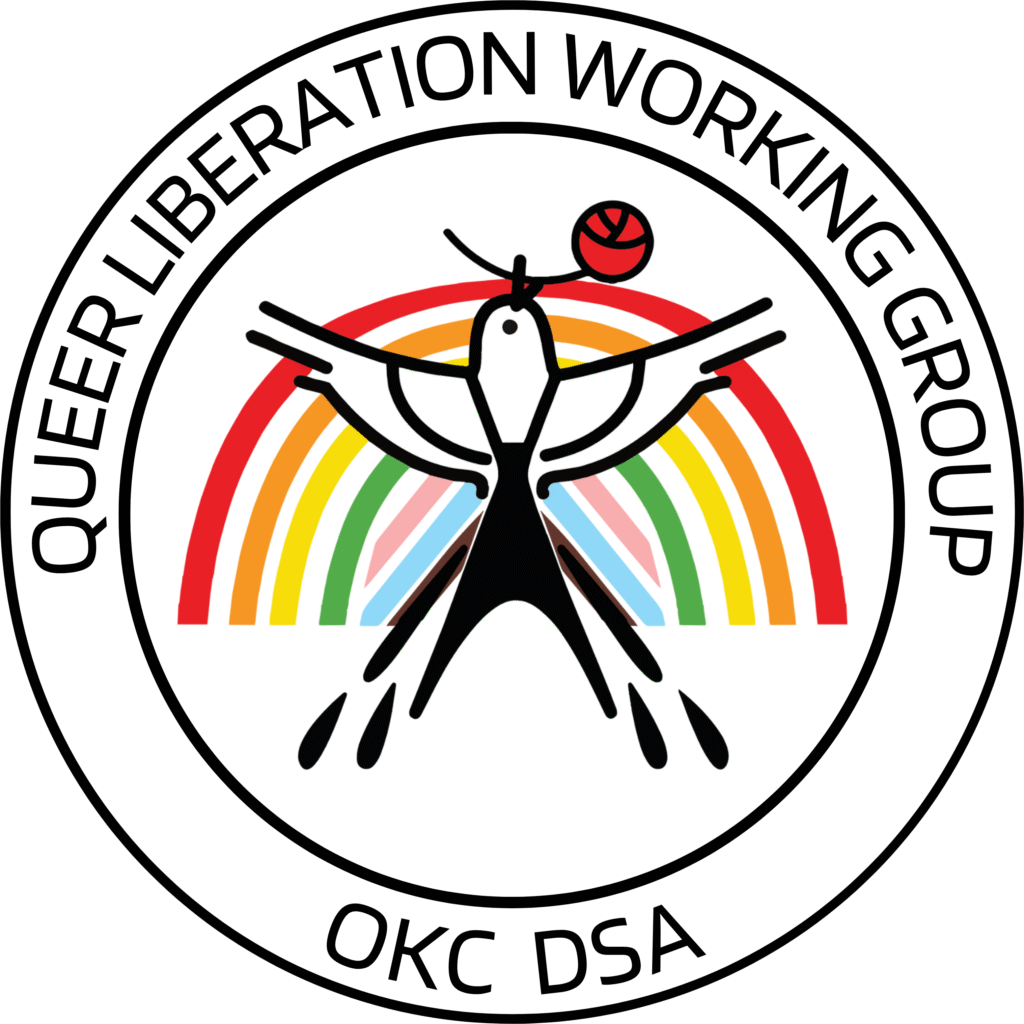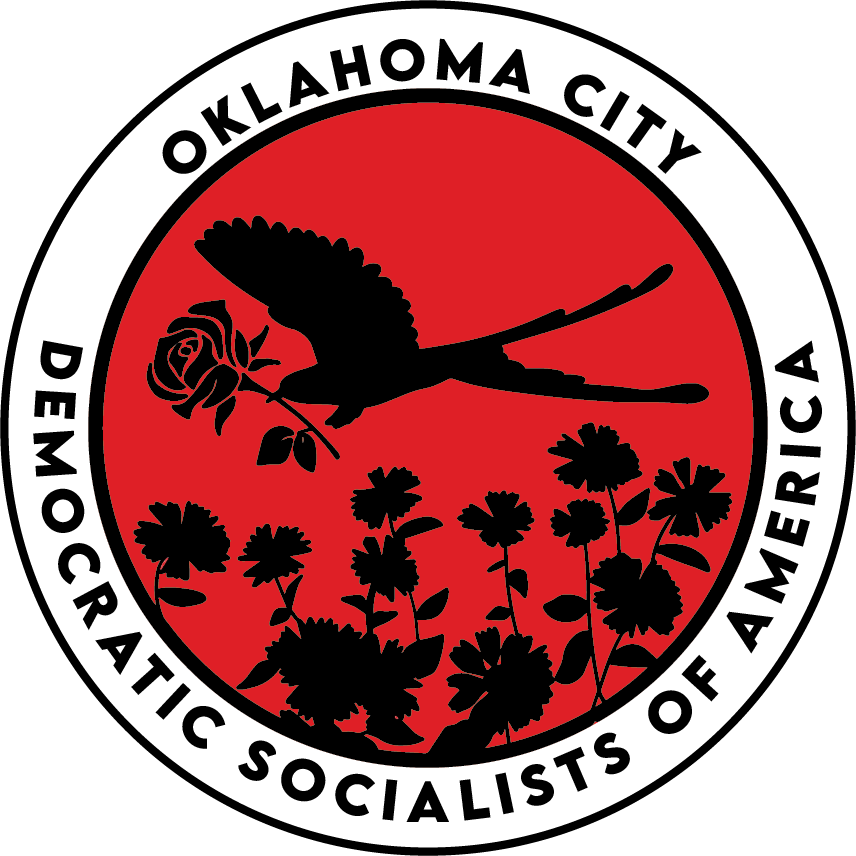While there are relatively few studies available that examine medical debt in the queer community, the available research suggests that queer people are more likely to experience medical debt than their CIS counterparts. The goal of this initiative is to share information and resources, particularly in the queer community, regarding eligibility for “Charity Care.” Charity Care refers to medically necessary health care provided for free or at a reduced cost to people with limited income who cannot afford to pay for treatment otherwise.

The information below was compiled by members of the Queer Liberation Working Group (QLWG) of Oklahoma City DSA.
What is Medical Financial Aid
(AKA “Charity Care”)?
The Internal Revenue Service (IRS) defines Medical Financial Assistance, also known as “Charity Care,” as “free or discounted health services provided to persons who meet the organization’s eligibility criteria for financial assistance and are unable to pay for all or a portion of the services.” Depending on their eligibility criteria, hospitals may provide charity care to both uninsured and insured patients.
Among other government regulations, federal law requires that nonprofit hospitals—which account for nearly three-fifths (58%) of community hospitals (Fast Facts on U.S. Hospitals, 2024)—provide some level of charity care as a condition of receiving tax-exempt status, and many state governments require all or a subset of hospitals to extend eligibility for charity care to certain groups of patients.
Within the broad parameters set by government regulation, hospitals establish their own charity care policies, which vary in terms of eligibility criteria, application procedures, and the levels of charity care provided. While hospitals bear the direct costs of providing charity care, support from donors and federal, state, and local governments may cover some or all of these expenses.
For more information about how medical debt disproportionately affects queer people, see this report from Community Catalyst: Curbing Medical Debt to Ensure Health and Economic Justice for LGBTQ+ People.
How Do I Apply for Financial Aid?
The process is different depending on the hospital of your choice, and usually only covers medically necessary/emergency care. Medically Necessary Care is defined as “healthcare services or supplies which meet all of the following requirements:
- ordered by a physician and appropriate and necessary for the symptoms, diagnosis, or treatment of the medical or mental health condition;
- provided for the diagnosis or direct care and treatment of the medical or mental health condition;
- meet the standards of good medical practice within the medical and mental health community in the service area;
- not primarily for the convenience of the patient or a provider; and
- the most appropriate level or supply of service that can safely be provided.”
In most cases, your eligibility will be determined by your declared level of income (see Federal Poverty Guidelines), and applications will require you to disclose personal financial information in order to qualify. Expect to be asked to share tax information, pay stubs, social security payments, details about assets, etc.
The process may be quicker if you ask about financial assistance at the time of service instead of when you receive a bill, but this is not necessary. Most programs have a time limit, so make sure you apply within 240 days of the billing date! Anticipate that these hospitals may drag their feet in responding to you, have long wait times to talk on the phone, and take weeks to process your financial aid application.
- After you submit the required documentation, they may ask you for more information, or for documents to be resubmitted with minor changes.
- These systems intentionally make this process frustrating in the hopes that people will give up. If you know that you meet the eligibility criteria, and you can dedicate the time and energy to do so, persist.
- We shouldn’t have to jump through this many hoops to have access to affordable medical care, but it’s the reality of our current system.
Federal Poverty Guidelines
The Federal Poverty Guidelines are set annually by the United States Department of Health and Human Services.
- The poverty line sets income thresholds to determine eligibility for public assistance programs.
- The Federal Poverty Guidelines take household size into account.
- Medical financial aid programs use the Federal Poverty Guideline to assess whether a patient is eligible for medical financial aid.
Generally, hospitals offer financial aid to patients whose household income is a higher percentage of the poverty line, from 200% to 400%.
- For example, say your hospital’s policy offers charity care to patients with a household income of up to 300% of the poverty line.
- A household of two people with a combined annual income of $60,000 would meet the financial eligibility requirements in 2025.
Some hospitals also offer financial discounts to patients whose income is above the income threshold based on the poverty line, but whose medical bills total more than a certain percentage of the patient’s annual household income.
- For example, say your hospital’s policy offers charity care to patients with a household income of up to 200% of the poverty line, or Catastrophic Financial Assistance to patients whose care costs 25% or more of their income.
- A household of two people with a combined total annual income of $60,000 would not qualify for medical financial aid based on income in 2025, but if their medical bills totaled $20,000, they would qualify for Catastrophic Financial Aid, because $20,000 is more than 25% of their household annual income.
Where can I go in Oklahoma City?
The following hospitals in the Oklahoma City area have some degree of financial aid for patients who are unable to pay for their medical bills. More details about each facility can be found in our Medical Financial Aid Resources document. Most programs have a time limit, so make sure you apply within 240 days of receiving your bill!
If you don’t see your preferred hospital on this list, that does not mean that they don’t have a financial aid program. An internet search for “hospital name + financial aid” is usually enough to find out whether they have a financial aid program. You can also ask your care provider or someone in the business office of the hospital about financial aid and their application process.
Mercy Hospital – OKC
4300 W Memorial Rd
Oklahoma City 73120
If your household income is 400% or less than the Federal Poverty Guideline, you may qualify. They use a sliding scale, with the most assistance offered to patients with an income level at 200% or lower than the poverty line. Clients who are uninsured must first call the hospital’s Medicaid Eligibility Screening team at 855-420-7900 in order to apply for financial assistance.
Customer Service: 855-420-7900
OU Medical Center
700 NE 13th
Oklahoma City, OK 73104
Up to 100% coverage is available to people whose income is 200% of the federal poverty line or lower. Ask your care provider about charity care, and say that you would like an application and information packet.
OU Health: 866-656-8715
Customer Service: 888-472-0040
Integris Health Baptist Medical Center
3300 NW Expressway
Oklahoma City, OK 73112
Most patients whose income is 150% or less of the Federal Poverty Guidelines may have a 100% financial assistance discount. Other discounts from 79%-97% of the total cost may apply even if their income exceeds the 150% threshold, up to 300% of the poverty line.
Further eligibility and assistance information, a copy of Financial Assistance Policy, the Financial Assistance Application form and a plain language summary for the Financial Assistance Policy (English, Spanish or Vietnamese) are available by contacting the INTEGRIS Health Business Office at (855) 409-5458.
Integris Health Southwest Medical Center
4401 S Western
Oklahoma City, OK 73109
Integris Health Southwest should have a similar procedure and eligibility system as the Integris Health Baptist Medical Center.
INTEGRIS Health Business Office: (855) 409-5458.
Southwest Campus: 405-636-7000
SSM Health St. Anthony Hospital – Oklahoma City
1000 N Lee Ave
Oklahoma City, OK 73102
Patients whose income is up to 400% of the Federal Poverty Level meet the financial eligibility requirement. Discounts of up to 100% of the amount billed may be available to patients with household income 200% of the poverty line or lower.
Financial Services Team: 888-918-3512
Oklahoma City Indian Clinic
4913 W Reno Ave
Oklahoma City, OK 73127
This Indigenous Clinic on I-40 and Meridian provides non emergency/preventative medical care. Documented members of federally recognized tribes qualify to receive medical care for free.
Main Clinic: 405-948-4900
What about Ambulances?
EMSA is the primary Ambulance Service Provider for the Oklahoma City area, and has a program known as EMSAcare for patients who cannot pay. The EMSAcare cost is $3.65 per month, which can be billed on your monthly City water bill. The first billing cycle begins in October, which is the first day coverage begins for new participants.
To opt-in or opt-out of the program: Call Utilities Customer Service at (405) 297-2833, or change your participation in the online Utilities account portal. If you are a renter and your property owner has opted out, call (405) 396-2888 to sign up.
Connect with QLWG
Follow @okcdsa on social media to find out about upcoming events.
Become a chapter member to join the Discord server and receive emails from organizers.
